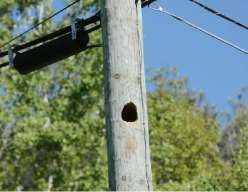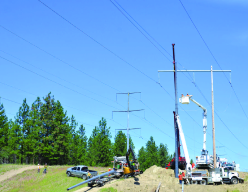ARTICLE | Standing Tall Against the Elements
DOWNLOAD PDF Severe weather reinforces utility’s decision to install fiberglass poles. By Steve Coltharp and Tim Vied, Western Kentucky Rural Electric Cooperative Corp. After losing more than 120 wood poles to Hurricane Ike in September 2008, Western Kentucky Rural Electric Co-operative Corp. (WKRECC) installed seven RS composite utility poles in its system on a trial basis. The composite poles were quickly put to the test when, in January 2009, a once-in-a-hundred-years ice storm rolled through the WKRECC territory. The storm took down more than 1600 wood poles; yet, while the composite poles were on circuits with damaged wood poles, not one composite pole was damaged. It took weeks for WKRECC to fully restore service to its customers. Hurricane Ike Western Kentucky is a serene place with gently rolling hills, meandering streams and rivers, and a lot of trees. WKRECC provides electric power to 38,000 customers living in four Western Kentucky counties. The cooperative’s 100 or so employees do their best to see that 11 substations, 15 miles (24 km) of transmission lines and 4000 miles (6437 km) of distribution lines reliably deliver electric power generated and transmitted by the Tennessee Valley Authority (TVA). This is a predominantly agricultural area of the United States where things change relatively slowly. However, things changed rather abruptly when the region was hit by not one but two major weather events in less than five months. Winston Chambers, a contract engineer with Patterson & Dewar Engineers, assesses damage to a double-circuit joint-use wood pole. First came Hurricane Ike, which surprisingly took an interior course northward over the WKRECC service territory. The hurricane brought sustained winds of 90 mph (145 kmph), toppled thousands of trees and destroyed more than 120 wood poles, knocking out power for weeks. A utility east of the WKRECC service territory had similar issues but not with about a dozen RS composite poles it had installed near Cincinnati, Ohio, U.S. Manufactured by RS Technologies, those poles emerged from the hurricane unscathed. WKRECC took notice. Actually, even before the storm, WKRECC has decided to purchase seven composite poles for a trial deployment. There were several primary reasons for trying out the composite poles: high strength, long life, zero maintenance, environmentally benign materials, light weight, and a modular design that makes installation easy. These benefits helped offset the somewhat-higher initial cost of the composite poles, which were about twice as much as the wood distribution poles they replaced. However, the freight costs for the composite poles were half as much as for wood poles and, according to the contractors who installed them, the composite poles were easier and faster to install, all of which saved money. During the Ike recovery phase in October 2008, the composite poles were installed along a road not too far from WKRECC’s warehouse. The next pole in the line was steel and stood across the road near an intersection. The Ice Storm It did not take WKRECC long to determine the right purchasing decision had been made. On Jan. 27, 2009, a vast swath of the United States was slammed by a brutal winter storm that coated everything with a thick layer of ice. More than 1600 wood poles went down. Many of them snapped like toothpicks under the loads brought about by ice-ladened lines, or by trees and heavy branches falling against the lines. WKRECC lost its entire system, which is fed by TVA, who was down for five days before it was able to restore its transmission. However, it took WKRECC 21 days to completely restore power, and this was only possible because of the mutual assistance help of 500 cooperative volunteers from North Carolina, Alabama, Mississippi, Florida, and Tennessee. An extreme icing load caused this double-circuit double-deadend wood pole to snap. Things got a little crowded at WKRECC’s warehouse at times during this all-hands-on-deck period of reconstruction. In addition to storing supplies, the warehouse complex was also the site for putting up the volunteers and feeding them until all the work was done. Strength and Resilience Amidst all of the wreckage along the road where the composite poles were installed, the only pole damaged was the steel pole with two breaks. In other words, the composites held their designed load, plus the ice, plus a portion of the load formerly carried by the steel pole across the street. This was possible because of the high amount of elastic strain energy composite poles are able to absorb in high-load situations. Needless to say, the strength and resilience of these poles in such harsh conditions were both surprising and impressive. This wood pole was used to replace a steel pole that was damaged by the ice storm, because there were no composite poles in stock. As a result of this very positive experience, WKRECC decided to install three large-diameter composite poles to carry the lines out of a new substation considered to be in a critical location. Again, the assembly and installation of these poles were quick and straightforward. Not long after the substation project was completed in September 2009, WKRECC ordered 20 additional RS distribution poles to be part of a new 7.2-kV distribution line that is about 8000 ft (2438 m) of 397-kcmil spacer cable. The contractor’s feedback was that the lightweight composite poles were easy to handle and easy to set. The composite poles have to be drilled to fasten framing to them, and the contractor drilled these holes easily in the field. Assembly went quickly, the wire was strung, and the line was put into service soon thereafter. Ice buildup on a typical three-phase pole. After the extreme weather events it has experienced recently, WKRECC now must consider more than just the initial capital costs in its purchasing decisions when buying poles. As mentioned earlier, shipping and installation costs with composite poles are less than that of wood poles. There is also the strength factor, which certainly plays a role in ensuring reliability and lowering maintenance costs. Unlike wood poles, composite poles do not require derating over time. In fact, their superior strength allows greater flexibility when retrofitting larger-sized conductor or for placing poles farther apart when using low-sag conductors. Construction Pluses Because RS composite poles are hollow, they require different installation methods and hardware. Hardware is now






